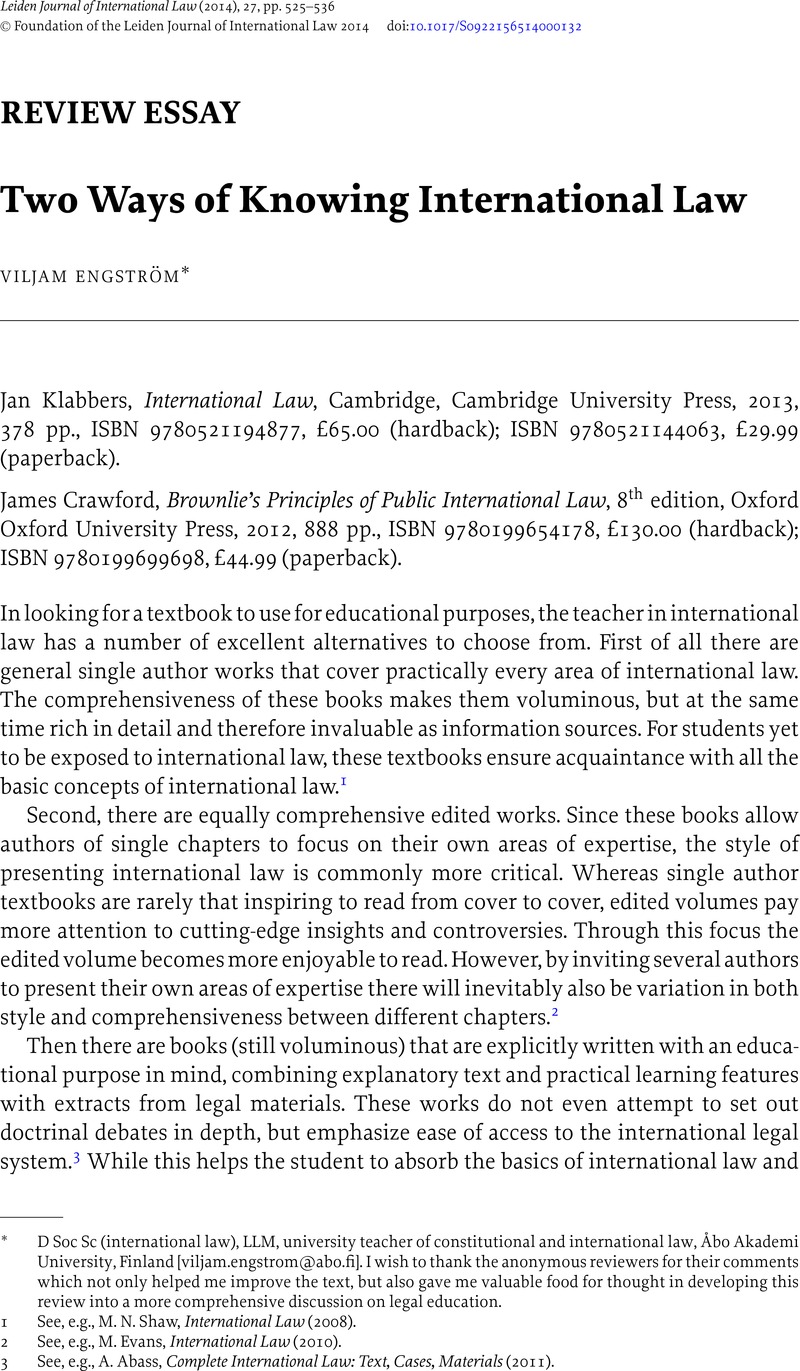Published online by Cambridge University Press: 24 April 2014

1 See, e.g., M. N. Shaw, International Law (2008).
2 See, e.g., M. Evans, International Law (2010).
3 See, e.g., A. Abass, Complete International Law: Text, Cases, Materials (2011).
4 See, e.g., M. Dixon, Textbook on International Law (2013).
5 For one interesting study, see Hakalehto-Wainio, S., ‘The Challenges in Teaching Law – Tort Law as an Example’, (2009) 3–4 Tidskrift utgiven av Juridiska Föreningen i Finland (JFT) 269Google Scholar. Similar findings are at the heart of e.g. Maughan, C., ‘Why Study Emotion?’, in Maharg, P. and Maughan, C., Emerging Legal Learning: Affect and Legal Education: Emotion in Learning and Teaching the Law (2011) 11, at 28Google Scholar, and Jacobson, M. H. S., ‘A Primer on Learning Styles: Reaching Every Student’, (2001) 25 Seattle University Law Review 139, at 139–40Google Scholar.
6 See MacLellan, E. and Soden, R., ‘Expertise, Expert Teaching, and Experienced Teachers’ Knowledge of Learning Theory’, (2003) 35 Scottish Educational Review 110, at 112Google Scholar, and Sfard, A., ‘On Two Metaphors for Learning and the Dangers of Choosing Just One’, (1998) 27 Educational Researcher 4, at 10CrossRefGoogle Scholar.
7 See Sfard, ibid., at 6–7.
8 S. Rowland, Enquiring University (2006), at 17–18.
9 See Maughan, supra note 5, at 29.
10 See, e.g., Stark, R.et al., ‘Overcoming Problems of Knowledge Application and Knowledge Transfer’, in Boshuizen, H. P. A., Bromme, R., and Gruber, H. (eds), Professional Learning: Gaps and Transitions on the Way from Novice to Expert (2004), 1 at 1Google Scholar.
11 See, e.g., Feltovich, P. J., Prietula, M. J., and Ericsson, K. A., ‘Studies of Expertise from Psychological Perspectives’, in Ericsson, A. K.et al., The Cambridge Handbook of Expertise and Expert Performance (2006), 41–67, as well as many other contributions in the same bookCrossRefGoogle Scholar.
12 See, e.g., Maughan, supra note 5, at 29, and Walsh, T., ‘Putting Justice Back Into Legal Education’, (2008) 17 Legal Education Review 119Google Scholar.
13 Sinatra, G. and Mason, L., ‘Beyond Knowledge: Learner Characteristics Influencing Conceptual Change’, in Vosniadou, S. (ed.), International Handbook of Research on Conceptual Change (2008), 560Google Scholar.
14 An introduction, albeit not in the field of legal research, is provided by Tippett, C. D., ‘Refutation Text in Science Education: A Review of Two Decades of Research’, (2010) 8 International Journal of Science and Mathematics Education, 951CrossRefGoogle Scholar.
15 Report of the International Law Commission, Sixty-Third session (26 April–3 June and 4 July–12 August 2011), General Assembly, Official Records, Sixty-Sixth session, Supplement No. 10 (A/66/10).
16 I. Brownlie, Principles of Public International Law (2008), at 575–8.
17 Vermunt, J. D., ‘The Power of Teaching–Learning Environments to Influence Student Learning’, in Student Learning and University Teaching (British Journal of Educational Psychology Monograph Series) (2007), 73, at 74–7Google Scholar. For one overview of the discussion of learning styles in the US, see, e.g., E. A. DeGroff and K. A. McKee, ‘Learning Like Lawyers: Addressing the Differences in Law Student Learning Styles’, (2006) Brigham Young University Education and Law Journal 49.
18 See Vermunt, ibid., at 86.